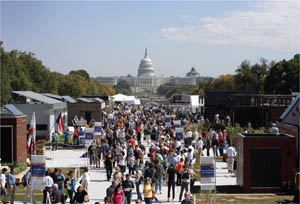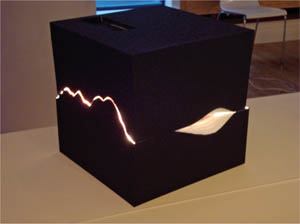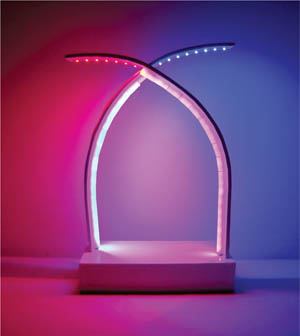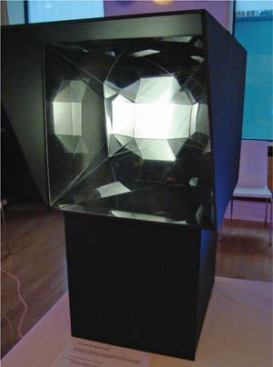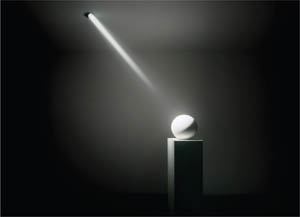This year, the competition received one of its best showings. Sixty-five students from a diverse range of programs including environmental policy, product design, and electrical engineering submitted projects. The students represented seven schools: Parsons the New School for Design, the Fashion Institute of Technology, Columbia University, Pratt Institute, Fordham University, the New York School for Interior Design, and New York University’s Tisch School of the Arts. Overall, the judges—a team of five professional architects and lighting designers—were impressed with the range of ideas expressed in the projects and the variety of materials used to represent light.
Three principal awards were given out. There also were two honorable mentions, one for craftsmanship and one for use of materials. First place went to J. Parkman Carter, a student enrolled in both the architecture and MFA Lighting Design programs at Parsons the New School for Design, for his project “Edge: Problems and Promise.” Presented as an internally illuminated box with different exterior treatments, the piece explores how light, in combination with edges, can lead the human eye to perceive different levels of darkness. As the first place winner, Carter received a $2,000 award and a trip to the 2010 Professional Lighting Designers’ Association workshop in Alingsas, Sweden.
New York School of Interior Design student Suerrisa Blecher received second place for her project called “Cusp.” She explored the point of transition using two intersecting arcs outfitted with red and blue LEDs. When the arcs meet, the colors combine to create purple light. Blecher received a $1,000 prize and a trip to the GE Lighting & Electrical Institute at Nela Park in Cleveland.
The third place winner, Megan Pfeffer, also an MFA Lighting Design student at Parsons the New School for Design, explored the competition brief using psychological theories on luminality. Presented as a series of reflecting planes within an enclosure, perception of space transforms as light refracts off the different planar surfaces. Pferrer received a $500 award. As with the second place prize, Pfeffer also received a trip to the GE Lighting & Electrical Institute in Cleveland. For further information about the IESNYC student competition, go to iesnyc.org. ED
Erco’s Light Perspectives As part of the celebration for its 75th anniversary in 2009–10, Erco Lighting has written a new lighting reference book, Light Perspectives. The 268-page volume enhances its text by using luxurious photographs and clear illustrative diagrams to explore lighting concepts, techniques, technologies, and terms. The book’s 21 chapters are arranged in three sections: Light (an examination of the qualities of light), Space (the relationship between light and space), and Perspectives (light as it relates to culture). Each chapter focuses on a specific lighting term and presents the reader with the fundamentals of light and lighting—everything from issues of light and dark to color temperature and to spatial patterns.
Although the project images included in the book come from work in which Erco’s products have been specified, the text does not specifically promote the company or its products. Rather, it is a first-rate discussion of the principles of architectural lighting design, one that manages to take a complex subject covering a vast amount of information and breaks it down in an accessible way regardless of the reader’s background or familiarity with lighting. Light Perspectives is a welcome addition to the library of lighting books and reference materials. ED
NYSERDA Implements New SSL Policy To respond to the abundance of diverse manufacturer claims regarding solid-state lighting (SSL) products, the New York State Energy Research and Development Authority (NYSERDA) has implemented a new policy for its Existing Facilities Program. Starting June 1, NYSERDA will accept only SSL products listed by either Energy Star or the DesignLights Consortium’s Qualified Products List. NYSERDA has made the change in order “to ensure that the products [they] support will deliver promised light levels and energy savings throughout their product lives.” Furthermore, the Existing Facilities Program will require that both LM-79 and LM-80 test documentation be included for all SSL products specified on performance-based projects.
Currently, NYSERDA does not provide any incentives for SSL products, save for those listed under the “Exit Sign” category. Going forward, however, NYSERDA will not provide incentives for products that have not met LM-79 and LM-80 testing criteria. In addition to these requirements, NYSERDA will require that all SSL products be backed by a three-year manufacturer’s unconditional warranty. For further details, visit NYSERDA’s website: nyserda.org/programs/Existing_Facilities/default.html. ED
NEMA Publishes White Paper on SSL Dimming The latest offering on the solid-state lighting (SSL) product documentation front is the National Electrical Manufacturers Association’s (NEMA) white paper: LSD 49-2010 Solid State Lighting for Incandescent Replacement—Best Practices for Dimming. With its release, LSD 49 joins NEMA’s compendium of white paper reports on a variety of lighting topics.
Drafted by NEMA’s Solid-State Lighting Section, chaired by Robert Hick of Leviton Manufacturing, the paper outlines recommended practices for the dimming and design of screw-based incandescent replacement SSL products. The goal of the document is to promote coordination between control, power supply, and LED modules between manufacturers in order to achieve industry-wide synchronicity for all LED-based luminaire products that enter the market.
